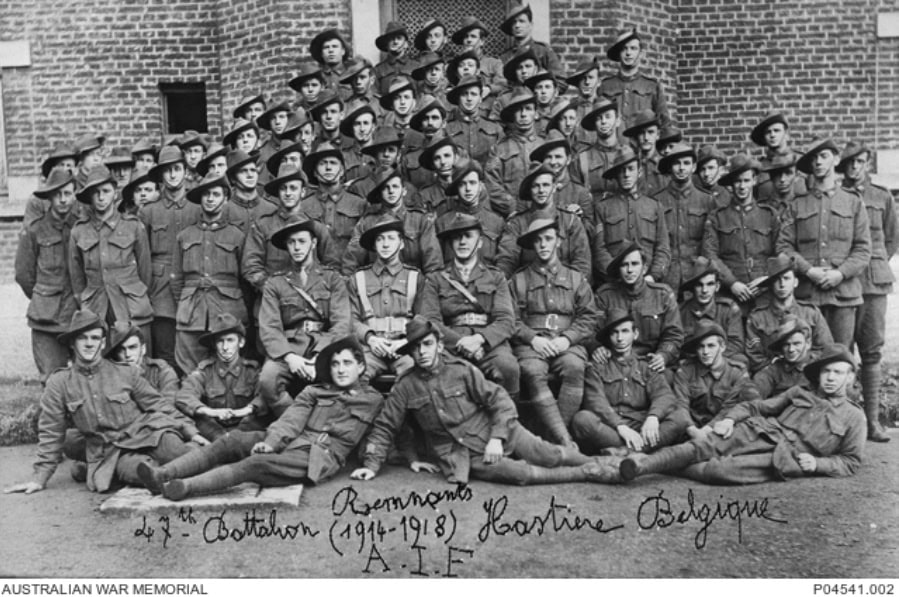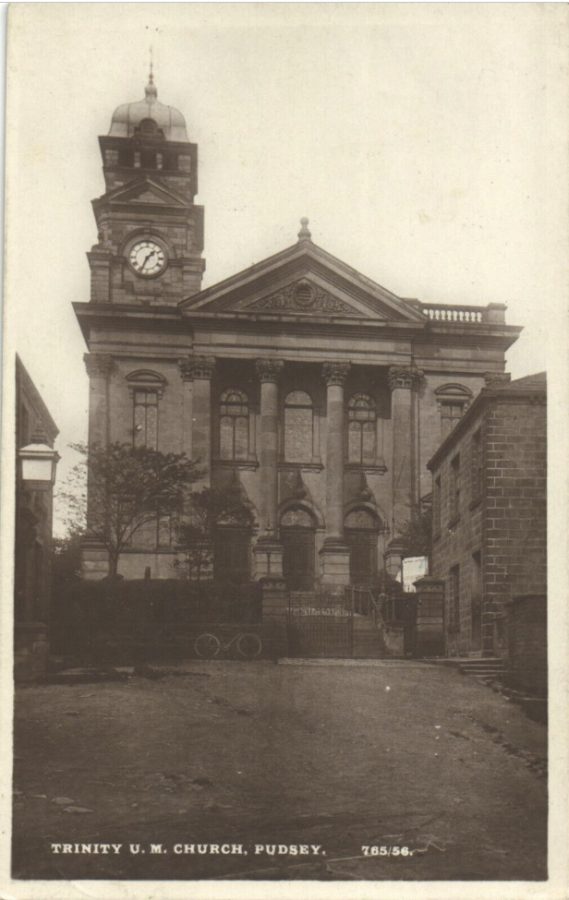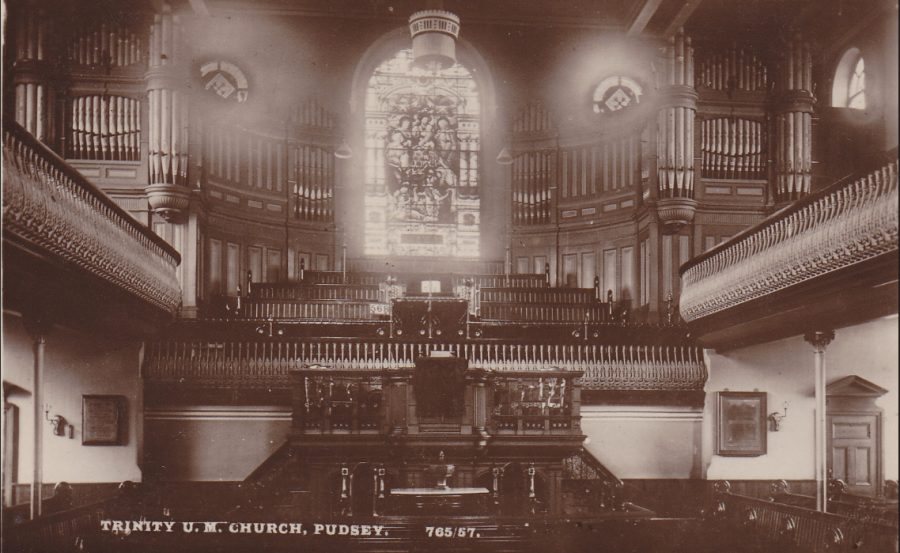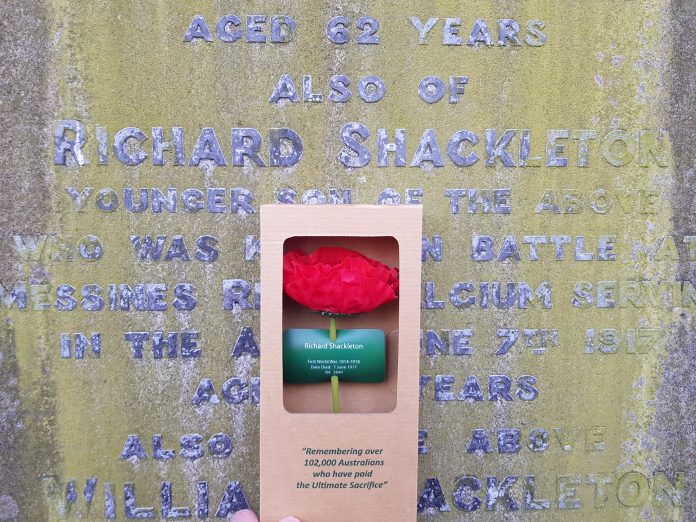A remembrance poppy dedicated to the life of a Pudsey soldier, retraces his journey across the oceans and finally comes home, writes Damon Sugden.
Today is ANZAC Day, observed on April 25 each year, and is a day of remembrance, honouring the members of the Australian and New Zealand Army Corps (ANZAC) who served and died in all wars, and peacekeeping operations.
The tradition began in 1916 to commemorate the allied landings at Gallipoli, Turkey, during World War I – a campaign that marked the first major military action fought by Australian and New Zealand forces during that war. This day of reflection not only recognises the sacrifices of the ANZAC forces but also symbolises the birth of national consciousness for both nations.

ANZAC Day holds relevance even thousands of miles away here in the UK, where many people have ties to relatives who served in the ANZAC forces. It serves as a reminder of the enduring bonds forged through shared experiences in wartime, bridging continents and generations. This makes ANZAC Day not just a national day of remembrance but an international one, connecting communities around the world.
Sometimes those enduring bonds are lost, but like a boomerang can come home unexpectedly out of the blue. One of those connections is to a young man called Richard Shackleton, who is named on Pudsey Cenotaph and has a poignant family memorial in Pudsey Cemetery, but is also remembered in Australia.
I’m a keen researcher of both Pudsey’s magnificent cenotaph and cemetery, and have recently been looking into the lives of our local lads who served and died with ANZAC forces in WW1.
It was a pleasant surprise to receive a gift from Australia connected to one of them; Skip, who lives in Perth, Western Australia had acquired via donation an ANZAC Poppy dedicated to Sergeant Richard Shackleton, late of Pudsey. Skip generously sent the Poppy home to the UK to be reunited with Richard’s modern family. There is a twist to this tale, but first let us look at the young man’s life that we are remembering today, April 25th 2024.

Born 1896 in Chorley, Richard was the second son of William and Mary Shackleton of Craven House, Pudsey. Hailing from Dewsbury, the family had moved to Pudsey so that architect William Shackleton could complete the impressive new Trinity Chapel that opened at the top of Lowtown in 1899.

The family stayed in Pudsey and made many friends here, and William would go onto make many more contributions to the Town, not least the design of the distinctive Pudsey Borough coat of arms, and the architecture of the Pudsey Picture House cinema. The family were distant relations of and also knew the remarkable Antarctic explorer Sir Ernest Shackleton.

William and Mary had three children – Catherine, and sons John and Richard who both emigrated to Australia before 1914.
By the time he was 17, Richard was 5 foot 3 inches tall with brown hair and blue eyes and contemplating what to do with his life. He emigrated to Australia in November 1913 to meet up with his older brother John. A very capable young man from a capable family, he settled well at Butterfield Street, Herston, in Brisbane working as an engineer.
His next move may have been inspired by heroic tales of ANZAC exploits on the Gallipoli peninsula, which started on 25 April 1915 with an amphibious landing, but got bogged down above the beaches. Richard enlisted in the Australian Army on the 6th July 1915 at Brisbane, as a cadet engineer, having been in Australia only for 1 year and 7 months. He was given the Service number 2840.
After training, Richard was deployed to the Middle East and arrived at Zeitoun, Lebanon 31 Oct 1915 but was delayed and missed his train. He finally met up with the 15th Battalion Australian Infantry Forces at the Ismaelia canal, after a long journey to Egypt lasting 69 days. Conditions were really poor and Richard reports sick to hospital on 30th January. By the 3 March he has transferred to his final unit – C company of the 47th Btn AIF, who are training on reserve for the Sanai campaign.
The idea was for the Aussies to defend the vital Suez canal and drive off any Turkish incursions. For a while they were based at Tel-El-Kebir village, described by one Australian soldier as “a very dirty little place with a few dirty shops in it”. By coincidence the Leeds and the Bradford Pals were also in the same region at the same time, with the same orders.
Two months later Richard is honoured to be promoted to Corporal. Then instead of heading off to fight the Turks, the 47th board the Caledonia and sail from Alexandria to Marseilles. No more games of cricket in the desert – its time to face the Germans.
Landing in France on 9th June 1916, Richard is again twice promoted as NCO to Sergeant, then acting Colour Sergeant Major, as his unit finds itself in the worst of the fighting on the Somme.
For a young man from Pudsey who had only been an Australian for a short time, being made up to Colour Sergeant Major – a senior NCO in the Battalion shows he had a lot of respect from his peers and the experienced Battalion officers.
Richard continues to fight on the Somme at both Pozieres, and the Australian’s brave but futile attacks on Mouquet Farm during August and September 1916.
Then out of the blue, having survived the worst of those battles intact, he is hit by a bullet in the back, probably from a sniper on 15th November. He was triaged via the 38th Casualty Clearing Station and evacuated to England aboard the HS Asturias. Then admitted on 21 November, to 1st Western General Hospital in Fazakerley, Liverpool, for now, in safe hands.
Richard was discharged 30th December, and granted furlough for 2 weeks (I don’t know for sure, but I hope he returned home to visit his parents and sister), then reported to Perham Downs Camp on Salisbury Plain 16th January 1917. Not getting much of a break from the action, he is still needed and sails back to France on the SS Invicta from Folkestone and re-joins his unit on the 7 March.
In April of 1917 the 47th were trapped and almost surrounded at the first battle of Bullecourt. Richard survived another hazardous encounter, and was fighting alongside other Pudsey men who were members of the British Army’s 62nd (Territorial) Division, including the 2nd /7th & 8thLeeds Rifles Battalions, and Bradford and Guiseley Terriers.

Things were about to get more intense for Richard and the Aussies, as a massive attack was planned to uproot the Germans from Belgium during the Summer of 1917, using the biggest man made explosions in history…
In the early hours of 7th June, the German trenches were destroyed by the detonation of huge mines at the launch of the Battle of Messines. Approximately 10,000 German troops died in the opening minutes clearing a path for advancing British and Australian troops to move into. It is said that the explosions were so loud that they could be heard in London.
Sadly this is where Richard’s journey ends. He was killed in action some time that day, and buried by his mates close to where he fell. Exhaustive searches were later made to relocate his grave, originally reported 1 mile East of Messines, without any luck.
The surviving members of the 47th Battalion are pictured here in 1918, some of these men would have served with Sergeant Richard Shackleton.
Richard is now remembered on the Ypres (Menin Gate) Memorial Panel 7, the family grave in Pudsey Cemetery, on Pudsey Cenotaph, and in spirit on his ANZAC Poppy – now proudly back home in Pudsey.
Since I received that Poppy, I have managed to trace Richard’s closest family, not in Pudsey but still out in Brisbane. They keep his memory alive along with those of his father William, mother Mary, sister Catherine, and brother John. Their family archive is extensive and I hope one day to share more interesting stories of the Shackletons of Pudsey.
I’m interested to know if anyone has any stories to share about ANZAC relatives – there must be a few more in the West Leeds area.
Updates to this story and more information about Pudsey’s military history can be found here.
Lest we forget.
With thanks to Skip and Peter over in Oz for keeping their memories alive.
Sponsored content


